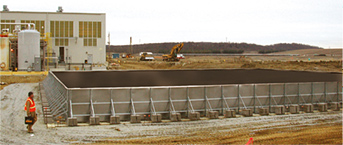Modular containment promises utility and adaptability with low costs
(As Appeared in Environmental Science & Engineering)

Aboveground containment systems have advanced to higher levels of versatility and price/performance with the introduction of modularity in their design, fabrication and installation. Among advantages reported for prefabricated modular tanks, including secondary containment, are lower costs, and rapid availability and shipment for emergency storage, spill containment and site remediation. In addition, these systems can be easily customized from standard components into almost any right angle configuration for irregularly-shaped areas: “L”, “T” and “S” shapes are typical.
They bolt together quickly with standard hand tools and can be knocked down for relocation or compact storage. When disassembled, the steel components of a 300,000-gallon tank can be stored on pallets in an 8 foot x 10 foot space. Modular tanks are equipped with various types of corrosion and chemical resistant flexible membrane liners for the storage and handling of virtually all liquids, hazardous wastes and sludges.
Among available application-specific flexible membrane liners are XR-5, Hypalon, PVC, HDPE and potable water grade polypropylene. Most often the appropriate liner is precut, sometimes seam-welded at the shop to the exact dimensions of the tank, and delivered with its metal components in one package
These systems may also be resized by adding or subtracting panels and refitting them with appropriate liners. Modular tanks from 250 to millions of gallons accept inlet/outlet piping, sumps and other product handling plumbing equipment, as well as floating covers. Leak detection can also be incorporated through geotextile or drainage net layers between the tank’s primary and secondary liners.
Squaring the circle Modular storage systems are not new when considering that many of today’s typical round tanks are designed and installed with modular curved panels which are repeatedly bolted or welded together in sequence. What is new is modularity as a total design concept unique to the rectilinear tank whose standardized parts can be configured to site patterns.
Tank installation can be completed on prepared, compacted ground free of depressions and sharp objects, or on concrete or asphalt beds as environmental regulations mandate. For example, assembled as an “L,” a tank could be cornered around obstructions. Modularity serves almost any asymmetrical configuration that is compatible with the available space.
Modularity also means accessibility–tanks that go most everywhere and fit anywhere, indoors or out. Hand-carried through doorways, hatches or windows, modular components bolt together rapidly in hard-to reach locations like basements, tunnels, upper floors, laboratories, rooftops and utility areas. Modular tanks could be the sensible alternative to breaking through walls to retrofit plant interiors with additional storage capacity.
A demonstration of the kind was performed when installing storage for fuel oil and hydraulic fluid in a salt mine chamber 2,500 feet below ground level. Hand-carried components for two 10,000 gallon modular tanks with covers were transported via the mine’s elevator and tunnel for bolt-together assembly in the deep site–averting the hazards of welding fumes trapped in poorly ventilated spaces.
Other savings in time and applications An often underappreciated cost factor in tank installation is that of transportation. In the case of modular rectangular tanks, all components are strapped to standard skids–each weighing approximately 3,000 lbs for site delivery by commercial flat bed trucks.
Heavy duty containment systems have met extremely hostile weather conditions on the North Slope of the Alaskan pipeline, and were successfully erected on tight deadlines in mid-winter at the Halifax and Montreal airports. In a challenging North American installation, a million gallon (U.S.) tank for emergency containment was shipped the next day and operational within three days.
Modular rectangular containment systems are believed to be nearing full partnership with conventional round tanks as facilities for hazardous materials containment, handling and treatment.
By Reed Margulis, President ModuTank Incorporated
